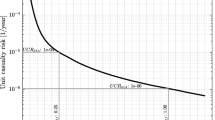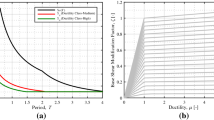Abstract
This study presents a risk-based decision support framework for seismic retrofit of building structures where the decision criterion is to minimize the sum of the cost required for the rehabilitation and the expected seismic loss over a specified time period. Probabilistic seismic hazard model (PSHM) and probabilistic seismic demand model (PSDM) are utilized for manipulation of the uncertainty propagation from the seismic hazard to the structural damage. A mathematical formula is then developed for probabilistic estimation of the seismic damage and losses over a specified time period. The analysis procedure is developed such that the effect of the different configurations of the decision inputs can be promptly observed. The proposed procedure is demonstrated by performing a decision analysis for a hypothetical RC building structure for determination of the optimal level of seismic rehabilitation using steel bracings.
Similar content being viewed by others
References
American Concrete Institute (1995). ACI-318: Building Code Requirements for Structural Concrete. Farmington Hills, Missouri, USA.
Cho, H. N., Min, D. H., and Lee, K. M. (2001). “Optimum life-cycle cost design of orthotropic steel deck bridges.” International Journal of Steel Structures, KSSC, 1 (2), pp. 141–152.
Cornell, C. A., Jalayer, J., Hamburger, R. O., and Foutch, D.A. (2002). “Probabilistic Basis for 2000 SAC Federal Emergency Management Agency Steel Moment Frame Guidelines.” Journal of Structural Engineering, 128 (4), pp. 526–533.
Corner, J., Buchanan, J., and Henig, M. (2001). “Dynamic Decision Problem Structuring.” Journal of Multi-Criteria Decision Analysis, 10 (3), pp. 129–141.
Ellingwood, B. R. and Wen, Y. K. (2005). “Risk-Benefit-Based Design Decisions for Low-Probability/High Consequence Earthquake Events in Mod-America.” Progress in Structural Engineering and Materials, 7 (2), pp. 56–70.
Ellingwood, B. R. (2001). “Earthquake Risk Assessment of Building Structures.” Reliability Engineering and System Safety, 74 (3), pp. 251–262.
FEMA-Federal Emergency Management Agency (1992). “A Benefit-Cost Model for the Seismic Rehabilitation of Buildings.” Report No. FEMA-227, Washington, D.C.
FEMA-Federal Emergency Management Agency (1995). “Typical Costs for Seismic Rehabilitation of Existing Buildings, Vol 1-Summary,” Report No. FEMA-156, Washington, D.C.
FEMA-Federal Emergency Management Agency (2000). “Prestandard and Commentary for the Seismic Rehabilitation of Buildings.” Report No. FEMA-356, Washington, D.C.
Frederick, S., Loewenstein, G., and O’Donoghue, T. (2002). “Time Discounting and Time Preference: A Critical Review.” Journal of Economic Literature, 40 (2), pp. 351–401.
HAZUS (2003). “HAZUS-MH MR3-Technical Manual.” Federal Emergency Management Agency, Washington, D.C.
Iman, R. L. and Conover, W. J. (1980). “Small Sample Sensitivity Analysis Techniques for Computer Models, with an Application to Risk Assessment.” Communications in Statistics, A9, No. 17, pp. 1749–1842.
Kleijnen, J. P. C. (1974). “Statistical Techniques in Simulation: Part 1.” Marcel Dekker, Inc., New York, NY.
McGuire, R.K. (2004). “Seismic Hazard and Risk Analysis.” EERI Monograph, Earthquake Engineering Research Institute.
Parsonage, M. and Neuburger, H. (1992). “Discounting and health benefits.” Health Economics, 1 (1), pp. 71–76.
Song, J. and Ellingwood, B. R. (1999). “Seismic Reliability of Special Moment Steel Frames with Welded Connections II.” Journal of Structural Engineering, 125 (4), pp. 372–384.
USGS (2008). US Geological Survey National Seismic Hazard Mapping Project, http://earthquake.usgs.gov/
Wen, Y. K. and Wu, C. L. (2001). “Uniform Hazard Ground Motions for Mid-America Cities.” Earthquake Spectra, 17 (2), pp. 359–384.
Wen, Y. K., Ellingwood, B. R., Veneziano D., and Bracci, J. (2003). “Uncertainty Modeling in Earthquake Engineering.” Report No. MAE-FD-2, Mid-America Earthquake Center.
Author information
Authors and Affiliations
Corresponding author
Rights and permissions
About this article
Cite this article
Park, J., Lee, DH. & Choi, E. Risk-based decision support for seismic rehabilitation of structures. Int J Steel Struct 9, 107–114 (2009). https://doi.org/10.1007/BF03249485
Received:
Accepted:
Issue Date:
DOI: https://doi.org/10.1007/BF03249485




